What's New
Displaying results 1991 - 2000 of 4899

Resource | Presentations,
Presented by Eamonn Murphy
Regional Director
UNAIDS Asia and the Pacific
at From barriers to bridges: Increasing access to HIV and other health services for trans people in Asia. 20 September 2017, Bangkok, Thailand

Resource | Guidelines,
Antiretroviral therapy using dolutegravir has several advantages over other regimens, including clinical superiority, improved side-effect profile, and reduced risk of viral resistance.
This is the first time this regimen will be offered as an affordable, generic, fixed-dose combination, which will increase access for millions of people living with HIV in low- and middle-income countries. Below are a set of key messages and questions and answers to guide communications around the announcement and respond to media inquiries.

Resource | Laws and Policies,
The policy on HIV Counseling and Testing is updated to provide quality standards in the conduct of HIV testing services consistent with the 2015 WHO Consolidated Guidelines on HIV Testing Services. This also to ensure wider access to HIV treatment in the country.

Resource | Publications,
Among key populations, who have low uptake of other testing options, reported benefits include privacy, convenience, pain-free testing, and ease of use. In 2016, the World Health Organization (WHO) released new guidelines recommending that HIVST should be offered as an additional approach to HIV testing services (strong recommendation, moderate quality of evidence). Although self-tests achieve acceptable sensitivity and specificity, all reactive and invalid results must be linked for confirmatory testing because self-tests are meant to be screening tests.
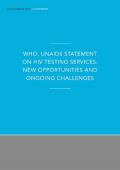
Resource | Publications,
HIV testing services are an essential gateway to HIV prevention, treatment, care and support services. The World Health Organization (WHO) and the Joint United Nations Programme on HIV/AIDS (UNAIDS) endorse and encourage universal access to knowledge of HIV status. Increased access to and uptake of HIV testing is central to achieving the 90–90–90 targets endorsed in the 2016 United Nations Political Declaration on Ending AIDS.
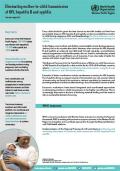
Resource | Fact Sheets,
In this Region, most mothers and children receive health services during pregnancy, delivery and in the months after birth. However, when services for HIV, hepatitis B and syphilis are planned and delivered through separate, uncoordinated, vertical programmes in the health system, this can result in redundancies, missed opportunities, and an inefficient use of resources. It can also make it harder for women and babies to get these important services.
The shared maternal, newborn and child health platform can coordinate and integrate interventions to achieve efficiencies and cost-effectively prevent these infections to achieve elimination.
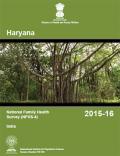
Resource | Publications,
This report presents the key findings of the NFHS-4 survey in Haryana, followed by detailed tables and an appendix on sampling errors. At the time of finalization of this report, wealth quintiles for the country as a whole were not ready. Therefore, on finalization of the national report, the breakup of key indicators by wealth quintiles for all states will be provided as an additional document and uploaded on the official website of MoHFW and IIPS.
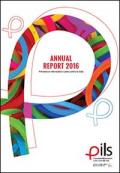
Resource | Publications,
Twenty years ago, PILS was born following a simple observation: almost ten years had passed since the first case of HIV had been registered in Mauritius, and yet there was no structure on our island, no treatment for HIV-positive people.
Over the last 20 years, PILS' vision and goals have evolved, but one thing remains constant: the will to change an improper social context, and to fight injustice and discrimination.
2016 was once again a pivotal year for PILS. We revised our 2014-2018 mid-term strategic plan, which allowed us to re-evaluate our direction and sharpen the measures through which we are working to end the AIDS epidemic by 2030. Two main needs emerged from this revision. First, the importance of strengthening operational systems and linking services. The idea is to strengthen links with existing partners in the implementation of programmes which are already underway, to ensure that those reached on the field are redirected to the services offered by PILS or the government. On the one hand, PILS has revised its internal organisation in order to develop synergies between the various functions that comprise the association today. Particular attention is given to collaborative work, with the setting up of several committees within the association, so that everyone can contribute as much as possible to decision-making.
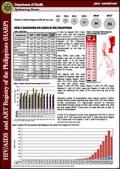
Resource | Fact Sheets,
In July to August 2017, there were 1,962 new HIV antibody sero-positive individuals reported to the HIV/AIDS & ART Registry of the Philippines (HARP). Eighty-seven percent of those were asymptomatic at the time of reporting.
Most (95%) were male. The median age was 27 years old (age range: 3 to 66 years). More than half of the cases were from the 25-34 year age group while 31% were youth aged 15-24 years.

Resource | Tools,
The Programme, currently in its third phase, is supported by a $16.7 million grant from the Global Fund to Fight AIDS, Tuberculosis and Malaria and will run until 2018. Led by Save the Children – Nepal (the Principle Recipient of the Grant), MSA promotes and protects the rights of key populations of MSM and transgender people and is building a foundation to ensure that regional and country-level community networks continue to be an essential partner in the HIV response. It focuses on strengthening community systems to improve coordination with local governments and health care providers, deliver concentrated and quality capacity development support, and provide technical assistance to ensure high intervention impact and sustainability.





